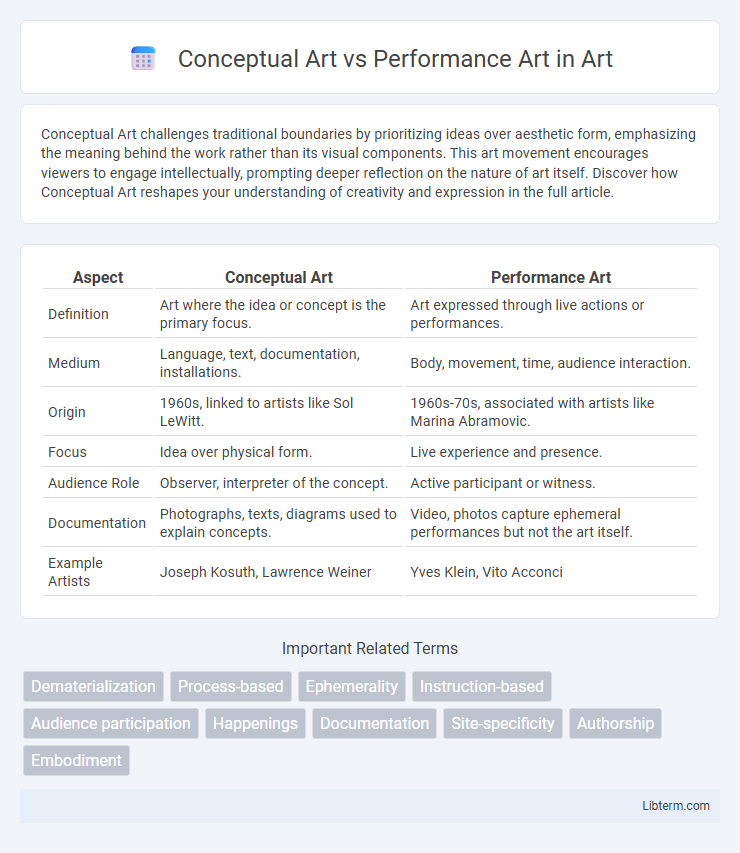Conceptual Art challenges traditional boundaries by prioritizing ideas over aesthetic form, emphasizing the meaning behind the work rather than its visual components. This art movement encourages viewers to engage intellectually, prompting deeper reflection on the nature of art itself. Discover how Conceptual Art reshapes your understanding of creativity and expression in the full article.
Table of Comparison
| Aspect | Conceptual Art | Performance Art |
|---|---|---|
| Definition | Art where the idea or concept is the primary focus. | Art expressed through live actions or performances. |
| Medium | Language, text, documentation, installations. | Body, movement, time, audience interaction. |
| Origin | 1960s, linked to artists like Sol LeWitt. | 1960s-70s, associated with artists like Marina Abramovic. |
| Focus | Idea over physical form. | Live experience and presence. |
| Audience Role | Observer, interpreter of the concept. | Active participant or witness. |
| Documentation | Photographs, texts, diagrams used to explain concepts. | Video, photos capture ephemeral performances but not the art itself. |
| Example Artists | Joseph Kosuth, Lawrence Weiner | Yves Klein, Vito Acconci |
Understanding Conceptual Art
Conceptual Art emphasizes the idea or concept behind the artwork over traditional aesthetic and material concerns, often challenging conventional definitions of art. It values intellectual engagement and communication of complex theories rather than visual appeal, using mediums like text, photography, and documentation to express artistic intent. By prioritizing meaning and process, Conceptual Art redefines art as a cognitive experience rather than a purely sensory one.
Defining Performance Art
Performance Art is a live artistic expression that emphasizes the artist's actions and presence as the primary medium, often blending elements of theater, dance, and visual art to convey conceptual ideas. Unlike Conceptual Art, which prioritizes the notion or concept behind the work over its physical form, Performance Art unfolds in real-time, creating an ephemeral experience that challenges traditional boundaries of art objects. This art form frequently engages audience interaction and situates the body as a critical site for exploring themes of identity, politics, and social commentary.
Historical Origins and Evolution
Conceptual Art emerged in the 1960s, prioritizing ideas over traditional aesthetics, with pioneers like Sol LeWitt and Joseph Kosuth emphasizing intellectual engagement. Performance Art began earlier in the 20th century, evolving from Dada and Futurist movements, focusing on live actions and bodily expression, as seen in the works of artists like Marina Abramovic and Allan Kaprow. Both forms challenged conventional art boundaries, with Conceptual Art evolving through institutional critique and Performance Art expanding through participatory and interdisciplinary practices.
Key Artists and Influencers
Key artists in Conceptual Art include Marcel Duchamp, whose readymades challenged traditional art definitions, and Sol LeWitt, known for his instruction-based works emphasizing ideas over aesthetics. Performance Art pioneers such as Marina Abramovic redefined the artist's role by using their body as a medium, while Allan Kaprow introduced "Happenings" that blurred life and art boundaries. Both movements significantly influenced contemporary art by prioritizing experience and concept over conventional forms.
Philosophical Foundations
Conceptual Art challenges traditional aesthetics by prioritizing ideas over physical objects, emphasizing the intellectual engagement between artist and audience. Performance Art embodies ephemeral experiences, exploring themes like identity, presence, and temporality through live actions, foregrounding the body as a medium. Both paradigms reject commodification, questioning art's ontology by emphasizing process, context, and meaning rather than material form.
Methods and Mediums
Conceptual Art prioritizes ideas over traditional aesthetics, utilizing mediums such as text, photography, and installations to convey philosophical concepts and challenge art's material boundaries. Performance Art employs the artist's body and live actions as the primary medium, often involving audience interaction and temporal experiences to emphasize presence and process. Both movements disrupt conventional art by shifting focus from static objects to dynamic expressions through distinct methods and mediums.
The Role of the Audience
In Conceptual Art, the audience plays a critical role in interpreting the underlying ideas, as the artwork often exists more as a concept than a physical object, demanding intellectual engagement and interpretation. Performance Art, by contrast, requires active participation or direct observation from the audience, making their presence essential to the completion and meaning of the artwork. Both forms challenge traditional art boundaries, emphasizing the dynamic interaction between artist, audience, and artwork over mere visual presentation.
Documentation and Preservation
Documentation in Conceptual Art primarily involves detailed records, photographs, and textual descriptions to capture the artist's ideas and instructions since the physical artwork may be minimal or nonexistent. Performance Art relies heavily on video recordings, photographs, and witness accounts to preserve ephemeral actions that cannot be physically stored, emphasizing the importance of media in maintaining the work's legacy. Preservation challenges differ as Conceptual Art's intangible essence demands archiving of intellectual content, while Performance Art requires managing multiple documentation formats to sustain its experiential and temporal nature.
Critical Reception and Controversies
Conceptual Art often faced criticism for prioritizing intellectual ideas over traditional aesthetics, sparking debates about the definition and value of art. Performance Art challenged conventional art forms with its ephemeral nature and direct audience engagement, leading to controversies over authenticity, commodification, and public disruption. Both movements provoked critical discourse on authorship, artistic intention, and the role of art institutions in validating non-traditional practices.
Lasting Impact on Contemporary Art
Conceptual Art revolutionized contemporary art by prioritizing ideas over aesthetic form, influencing numerous movements such as installation and digital art, and challenging traditional definitions of artistic value. Performance Art expanded the boundaries of art through live, ephemeral expressions that engage audiences directly, fostering new forms of participatory and experiential art practices. Both have left a lasting impact by redefining creativity and authorship, pushing contemporary art towards greater inclusivity and interdisciplinarity.
Conceptual Art Infographic

 libterm.com
libterm.com